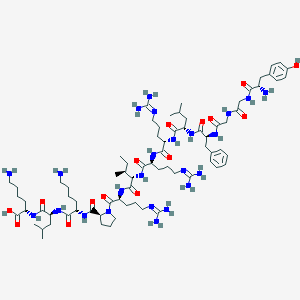

You can:
| Name | Mu-type opioid receptor |
|---|---|
| Species | Homo sapiens (Human) |
| Gene | OPRM1 |
| Synonym | hMOP M-OR-1 MOP opioid receptor, mu 1 opioid receptor [ Show all ] |
| Disease | Diarrhea Inflammatory disease Pain Major depressive disorder Migraine [ Show all ] |
| Length | 400 |
| Amino acid sequence | MDSSAAPTNASNCTDALAYSSCSPAPSPGSWVNLSHLDGNLSDPCGPNRTDLGGRDSLCPPTGSPSMITAITIMALYSIVCVVGLFGNFLVMYVIVRYTKMKTATNIYIFNLALADALATSTLPFQSVNYLMGTWPFGTILCKIVISIDYYNMFTSIFTLCTMSVDRYIAVCHPVKALDFRTPRNAKIINVCNWILSSAIGLPVMFMATTKYRQGSIDCTLTFSHPTWYWENLLKICVFIFAFIMPVLIITVCYGLMILRLKSVRMLSGSKEKDRNLRRITRMVLVVVAVFIVCWTPIHIYVIIKALVTIPETTFQTVSWHFCIALGYTNSCLNPVLYAFLDENFKRCFREFCIPTSSNIEQQNSTRIRQNTRDHPSTANTVDRTNHQLENLEAETAPLP |
| UniProt | P35372 |
| Protein Data Bank | N/A |
| GPCR-HGmod model | P35372 |
| 3D structure model | This predicted structure model is from GPCR-EXP P35372. |
| BioLiP | N/A |
| Therapeutic Target Database | T47768 |
| ChEMBL | CHEMBL233 |
| IUPHAR | 319 |
| DrugBank | BE0000770 |
| Name | Dynorphin A (1-13) |
|---|---|
| Molecular formula | C75H126N24O15 |
| IUPAC name | (2S)-6-amino-2-[[(2S)-2-[[(2S)-6-amino-2-[[(2S)-1-[(2S)-2-[[(2S,3S)-2-[[(2S)-2-[[(2S)-2-[[(2S)-2-[[(2S)-2-[[2-[[2-[[(2S)-2-amino-3-(4-hydroxyphenyl)propanoyl]amino]acetyl]amino]acetyl]amino]-3-phenylpropanoyl]amino]-4-methylpentanoyl]amino]-5-(diaminomethylideneamino)pentanoyl]amino]-5-(diaminomethylideneamino)pentanoyl]amino]-3-methylpentanoyl]amino]-5-(diaminomethylideneamino)pentanoyl]pyrrolidine-2-carbonyl]amino]hexanoyl]amino]-4-methylpentanoyl]amino]hexanoic acid |
| Molecular weight | 1603.99 |
| Hydrogen bond acceptor | 21 |
| Hydrogen bond donor | 22 |
| XlogP | -4.2 |
| Synonyms | 957H381 Dinorphin A (1-13) Dynorphin-(1-13) VFC23V742Z BDBM224024 [ Show all ] |
| Inchi Key | OVVIBUHLQIYUEU-IWIISZHXSA-N |
| Inchi ID | InChI=1S/C75H126N24O15/c1-7-45(6)61(70(111)94-53(25-17-35-87-75(83)84)71(112)99-36-18-26-58(99)69(110)93-50(21-11-13-31-76)64(105)96-56(38-44(4)5)67(108)95-54(72(113)114)22-12-14-32-77)98-65(106)52(24-16-34-86-74(81)82)91-63(104)51(23-15-33-85-73(79)80)92-66(107)55(37-43(2)3)97-68(109)57(40-46-19-9-8-10-20-46)90-60(102)42-88-59(101)41-89-62(103)49(78)39-47-27-29-48(100)30-28-47/h8-10,19-20,27-30,43-45,49-58,61,100H,7,11-18,21-26,31-42,76-78H2,1-6H3,(H,88,101)(H,89,103)(H,90,102)(H,91,104)(H,92,107)(H,93,110)(H,94,111)(H,95,108)(H,96,105)(H,97,109)(H,98,106)(H,113,114)(H4,79,80,85)(H4,81,82,86)(H4,83,84,87)/t45-,49-,50-,51-,52-,53-,54-,55-,56-,57-,58-,61-/m0/s1 |
| PubChem CID | 25075996 |
| ChEMBL | CHEMBL405618 |
| IUPHAR | N/A |
| BindingDB | 224024, 214798 |
| DrugBank | N/A |
Structure |  |
| Lipinski's druglikeness | This ligand has more than 5 hydrogen bond donor. This ligand has more than 10 hydrogen bond acceptor. This ligand is heavier than 500 daltons. |
| Parameter | Value | Reference | Database source |
|---|---|---|---|
| EC50 | 213.8 nM | PMID26785295, PMID26944625 | ChEMBL |
| EC50 | 214.0 nM | PMID26785295, PMID26944625 | BindingDB |
| Intrinsic activity | 0.83 - | PMID26785295, PMID26944625 | ChEMBL |
| Ki | 4.5 nM | PMID9686407 | BindingDB |
zhanglab![]() zhanggroup.org | +65-6601-1241 | Computing 1, 13 Computing Drive, Singapore 117417
zhanggroup.org | +65-6601-1241 | Computing 1, 13 Computing Drive, Singapore 117417